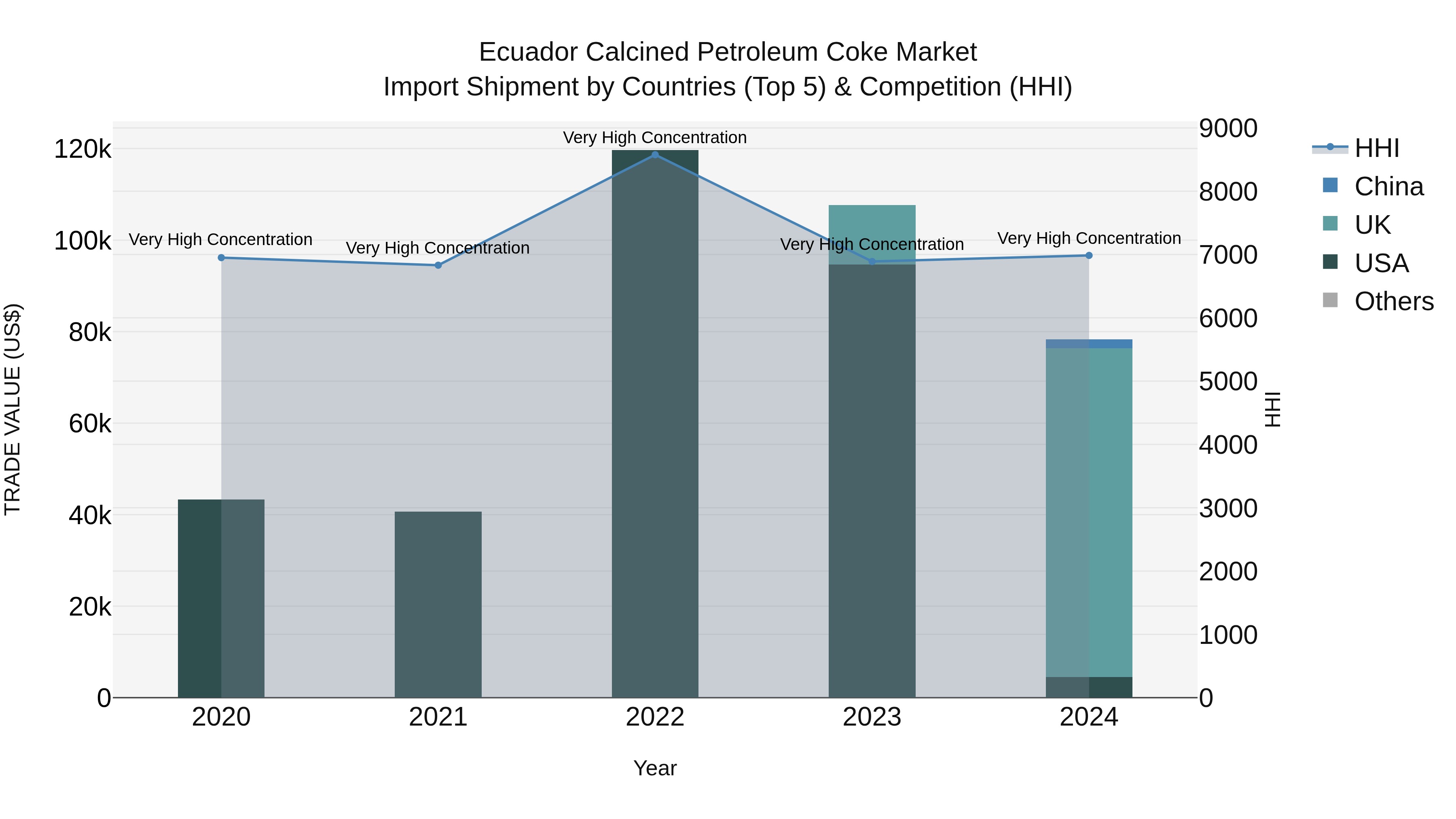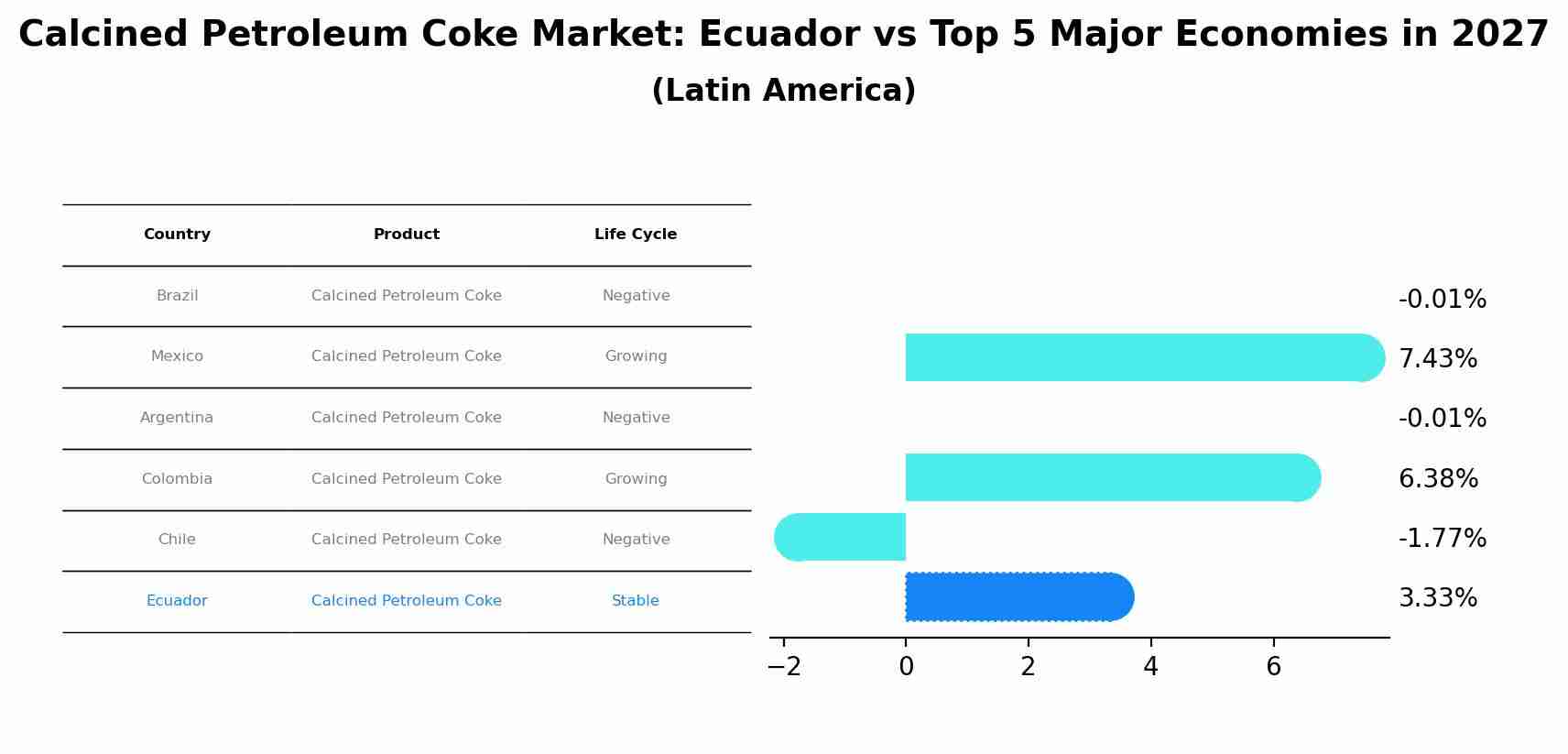Ecuador Calcined Petroleum Coke Market (2025-2031) | Companies, Share, Forecast, Growth, Analysis, Industry, Outlook, Segmentation, Revenue, Value, Size & Trends
| Product Code: ETC5252464 | Publication Date: Nov 2023 | Updated Date: Oct 2025 | Product Type: Market Research Report | |
| Publisher: 6Wresearch | Author: Bhawna Singh | No. of Pages: 60 | No. of Figures: 30 | No. of Tables: 5 |
Ecuador Calcined Petroleum Coke Market Top 5 Importing Countries and Market Competition (HHI) Analysis
Ecuador`s import of calcined petroleum coke in 2024 continued to be dominated by the UK, USA, and China. Despite a slight decrease in growth rate from 2023 to 2024, the compound annual growth rate (CAGR) for 2020-2024 remained strong at 15.96%. The High Herfindahl-Hirschman Index (HHI) indicates a high level of Market Top 5 Importing Countries and Market Competition (HHI) Analysis concentration among the top exporting countries, suggesting potential challenges for Market Top 5 Importing Countries and Market Competition (HHI) Analysis competition and diversification in the sector.

Calcined Petroleum Coke Market: Ecuador vs Top 5 Major Economies in 2027 (Latin America)
By 2027, Ecuador's Calcined Petroleum Coke market is forecasted to achieve a stable growth rate of 3.33%, with Brazil leading the Latin America region, followed by Mexico, Argentina, Colombia and Chile.

Ecuador Calcined Petroleum Coke Market Overview
The calcined petroleum coke market in Ecuador is influenced by its applications in the aluminum and manufacturing industries. Calcined petroleum coke is a key ingredient in the production of aluminum and other materials. The market is driven by the growing demand for aluminum and the expansion of the manufacturing sector in Ecuador.
Drivers of the market
The calcined petroleum coke market is driven by the increasing demand for this material in the aluminum and steel industries. As industries seek high-quality carbon materials for production processes, the demand for calcined petroleum coke is growing. Furthermore, the expanding industrial sector in Ecuador is contributing to the market`s growth, as manufacturers require calcined petroleum coke for various applications.
Challenges of the market
The calcined petroleum coke market in Ecuador is limited by low demand from the aluminum and steel industries, which are underdeveloped locally. Dependency on imports for raw petroleum coke increases costs, while global price volatility and environmental concerns about emissions restrict market growth.
Government Policy of the market
To support the aluminum, steel, and energy sectors, Ecuadors government provides incentives for the import and production of calcined petroleum coke. Policies include favorable trade regulations and tax benefits for industries that adopt this material in their production processes, promoting energy efficiency and sustainability.
Key Highlights of the Report:
- Ecuador Calcined Petroleum Coke Market Outlook
- Market Size of Ecuador Calcined Petroleum Coke Market, 2024
- Forecast of Ecuador Calcined Petroleum Coke Market, 2031
- Historical Data and Forecast of Ecuador Calcined Petroleum Coke Revenues & Volume for the Period 2021-2031
- Ecuador Calcined Petroleum Coke Market Trend Evolution
- Ecuador Calcined Petroleum Coke Market Drivers and Challenges
- Ecuador Calcined Petroleum Coke Price Trends
- Ecuador Calcined Petroleum Coke Porter`s Five Forces
- Ecuador Calcined Petroleum Coke Industry Life Cycle
- Historical Data and Forecast of Ecuador Calcined Petroleum Coke Market Revenues & Volume By Type for the Period 2021-2031
- Historical Data and Forecast of Ecuador Calcined Petroleum Coke Market Revenues & Volume By Anode Grade for the Period 2021-2031
- Historical Data and Forecast of Ecuador Calcined Petroleum Coke Market Revenues & Volume By Needle Grade for the Period 2021-2031
- Historical Data and Forecast of Ecuador Calcined Petroleum Coke Market Revenues & Volume By for the Period 2021-2031
- Historical Data and Forecast of Ecuador Calcined Petroleum Coke Market Revenues & Volume By End-user for the Period 2021-2031
- Historical Data and Forecast of Ecuador Calcined Petroleum Coke Market Revenues & Volume By Carburizing & Recarburizing for the Period 2021-2031
- Historical Data and Forecast of Ecuador Calcined Petroleum Coke Market Revenues & Volume By Electric Arc & Induction Furnaces for the Period 2021-2031
- Historical Data and Forecast of Ecuador Calcined Petroleum Coke Market Revenues & Volume By Others for the Period 2021-2031
- Ecuador Calcined Petroleum Coke Import Export Trade Statistics
- Market Opportunity Assessment By Type
- Market Opportunity Assessment By End-user
- Ecuador Calcined Petroleum Coke Top Companies Market Share
- Ecuador Calcined Petroleum Coke Competitive Benchmarking By Technical and Operational Parameters
- Ecuador Calcined Petroleum Coke Company Profiles
- Ecuador Calcined Petroleum Coke Key Strategic Recommendations
Frequently Asked Questions About the Market Study (FAQs):
1 Executive Summary |
2 Introduction |
2.1 Key Highlights of the Report |
2.2 Report Description |
2.3 Market Scope & Segmentation |
2.4 Research Methodology |
2.5 Assumptions |
3 Ecuador Calcined Petroleum Coke Market Overview |
3.1 Ecuador Country Macro Economic Indicators |
3.2 Ecuador Calcined Petroleum Coke Market Revenues & Volume, 2021 & 2031F |
3.3 Ecuador Calcined Petroleum Coke Market - Industry Life Cycle |
3.4 Ecuador Calcined Petroleum Coke Market - Porter's Five Forces |
3.5 Ecuador Calcined Petroleum Coke Market Revenues & Volume Share, By Type , 2021 & 2031F |
3.6 Ecuador Calcined Petroleum Coke Market Revenues & Volume Share, By End-user , 2021 & 2031F |
4 Ecuador Calcined Petroleum Coke Market Dynamics |
4.1 Impact Analysis |
4.2 Market Drivers |
4.2.1 Growing demand for calcined petroleum coke in various industries such as aluminum production, steel manufacturing, and energy generation. |
4.2.2 Increasing investments in infrastructure projects in Ecuador that require calcined petroleum coke as a key raw material. |
4.2.3 Favorable government policies and regulations supporting the growth of the calcined petroleum coke market in Ecuador. |
4.3 Market Restraints |
4.3.1 Volatility in raw material prices impacting the production cost of calcined petroleum coke. |
4.3.2 Environmental concerns and regulations related to the carbon emissions associated with the production and use of calcined petroleum coke in Ecuador. |
5 Ecuador Calcined Petroleum Coke Market Trends |
6 Ecuador Calcined Petroleum Coke Market Segmentations |
6.1 Ecuador Calcined Petroleum Coke Market, By Type |
6.1.1 Overview and Analysis |
6.1.2 Ecuador Calcined Petroleum Coke Market Revenues & Volume, By Anode Grade, 2021-2031F |
6.1.3 Ecuador Calcined Petroleum Coke Market Revenues & Volume, By Needle Grade, 2021-2031F |
6.1.4 Ecuador Calcined Petroleum Coke Market Revenues & Volume, By , 2021-2031F |
6.2 Ecuador Calcined Petroleum Coke Market, By End-user |
6.2.1 Overview and Analysis |
6.2.2 Ecuador Calcined Petroleum Coke Market Revenues & Volume, By Carburizing & Recarburizing, 2021-2031F |
6.2.3 Ecuador Calcined Petroleum Coke Market Revenues & Volume, By Electric Arc & Induction Furnaces, 2021-2031F |
6.2.4 Ecuador Calcined Petroleum Coke Market Revenues & Volume, By Others, 2021-2031F |
7 Ecuador Calcined Petroleum Coke Market Import-Export Trade Statistics |
7.1 Ecuador Calcined Petroleum Coke Market Export to Major Countries |
7.2 Ecuador Calcined Petroleum Coke Market Imports from Major Countries |
8 Ecuador Calcined Petroleum Coke Market Key Performance Indicators |
8.1 Average selling price of calcined petroleum coke in the Ecuadorian market. |
8.2 Capacity utilization rate of calcined petroleum coke production facilities in Ecuador. |
8.3 Number of new contracts or partnerships secured by calcined petroleum coke manufacturers in Ecuador. |
9 Ecuador Calcined Petroleum Coke Market - Opportunity Assessment |
9.1 Ecuador Calcined Petroleum Coke Market Opportunity Assessment, By Type , 2021 & 2031F |
9.2 Ecuador Calcined Petroleum Coke Market Opportunity Assessment, By End-user , 2021 & 2031F |
10 Ecuador Calcined Petroleum Coke Market - Competitive Landscape |
10.1 Ecuador Calcined Petroleum Coke Market Revenue Share, By Companies, 2024 |
10.2 Ecuador Calcined Petroleum Coke Market Competitive Benchmarking, By Operating and Technical Parameters |
11 Company Profiles |
12 Recommendations | 13 Disclaimer |
- Single User License$ 1,995
- Department License$ 2,400
- Site License$ 3,120
- Global License$ 3,795
Search
Thought Leadership and Analyst Meet
Our Clients
Related Reports
- Canada Oil and Gas Market (2026-2032) | Share, Segmentation, Value, Industry, Trends, Forecast, Analysis, Size & Revenue, Growth, Competitive Landscape, Outlook, Companies
- Germany Breakfast Food Market (2026-2032) | Industry, Share, Growth, Size, Companies, Value, Analysis, Revenue, Trends, Forecast & Outlook
- Australia Briquette Market (2025-2031) | Growth, Size, Revenue, Forecast, Analysis, Trends, Value, Share, Industry & Companies
- Vietnam System Integrator Market (2025-2031) | Size, Companies, Analysis, Industry, Value, Forecast, Growth, Trends, Revenue & Share
- ASEAN and Thailand Brain Health Supplements Market (2025-2031) | Strategy, Consumer Insights, Analysis, Investment Trends, Opportunities, Growth, Size, Share, Industry, Revenue, Segments, Value, Segmentation, Supply, Forecast, Restraints, Outlook, Competition, Drivers, Trends, Demand, Pricing Analysis, Competitive, Strategic Insights, Companies, Challenges
- ASEAN Bearings Market (2025-2031) | Strategy, Consumer Insights, Analysis, Investment Trends, Opportunities, Growth, Size, Share, Industry, Revenue, Segments, Value, Segmentation, Supply, Forecast, Restraints, Outlook, Competition, Drivers, Trends, Demand, Pricing Analysis, Competitive, Strategic Insights, Companies, Challenges
- Europe Flooring Market (2025-2031) | Outlook, Share, Industry, Trends, Forecast, Companies, Revenue, Size, Analysis, Growth & Value
- Saudi Arabia Manlift Market (2025-2031) | Outlook, Size, Growth, Trends, Companies, Industry, Revenue, Value, Share, Forecast & Analysis
- Uganda Excavator, Crane, and Wheel Loaders Market (2025-2031) | Strategy, Consumer Insights, Analysis, Investment Trends, Opportunities, Growth, Size, Share, Industry, Revenue, Segments, Value, Segmentation, Supply, Forecast, Restraints, Outlook, Competition, Drivers, Trends, Demand, Pricing Analysis, Competitive, Strategic Insights, Companies, Challenges
- Rwanda Excavator, Crane, and Wheel Loaders Market (2025-2031) | Strategy, Consumer Insights, Analysis, Investment Trends, Opportunities, Growth, Size, Share, Industry, Revenue, Segments, Value, Segmentation, Supply, Forecast, Restraints, Outlook, Competition, Drivers, Trends, Demand, Pricing Analysis, Competitive, Strategic Insights, Companies, Challenges
Industry Events and Analyst Meet
Whitepaper
- Middle East & Africa Commercial Security Market Click here to view more.
- Middle East & Africa Fire Safety Systems & Equipment Market Click here to view more.
- GCC Drone Market Click here to view more.
- Middle East Lighting Fixture Market Click here to view more.
- GCC Physical & Perimeter Security Market Click here to view more.
6WResearch In News
- Doha a strategic location for EV manufacturing hub: IPA Qatar
- Demand for luxury TVs surging in the GCC, says Samsung
- Empowering Growth: The Thriving Journey of Bangladesh’s Cable Industry
- Demand for luxury TVs surging in the GCC, says Samsung
- Video call with a traditional healer? Once unthinkable, it’s now common in South Africa
- Intelligent Buildings To Smooth GCC’s Path To Net Zero


















